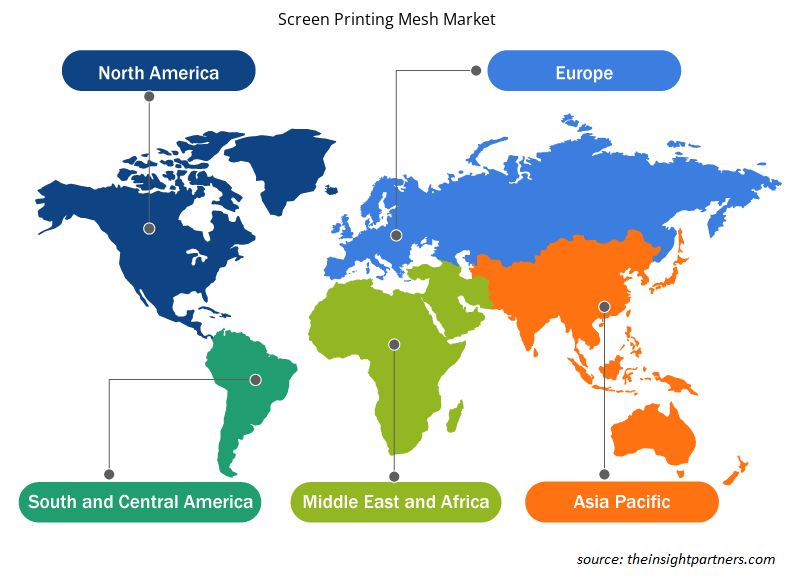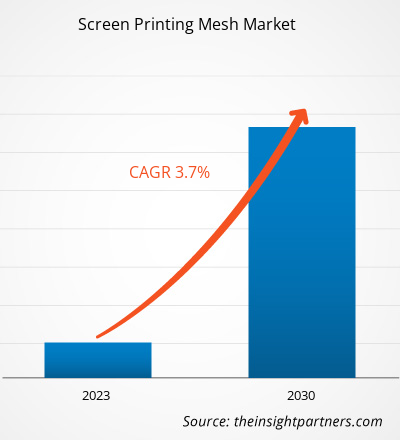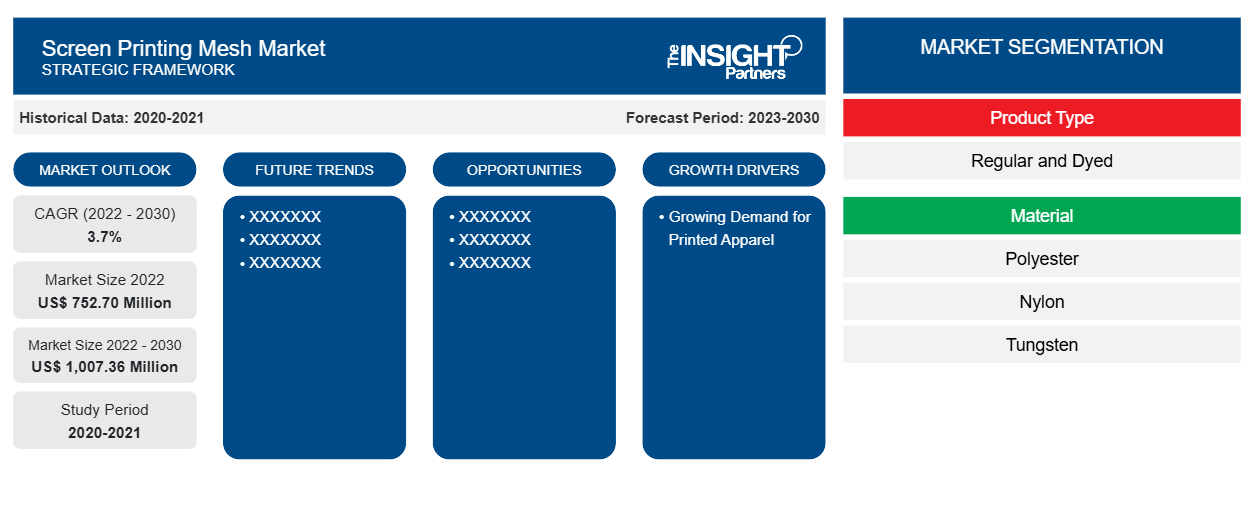[Rapporto di ricerca] Si prevede che il mercato delle maglie per la stampa serigrafica crescerà da 752,70 milioni di dollari nel 2022 a 1.007,36 milioni di dollari entro il 2030; si stima che registrerà un CAGR del 3,7% dal 2022 al 2030.
Approfondimenti di mercato e opinioni degli analisti:
La maglia per serigrafia si riferisce al tessuto o materiale intrecciato che viene teso strettamente su un telaio per creare uno schermo per la serigrafia. La maglia per serigrafia è disponibile in diversi conteggi di maglie. Le maglie per serigrafia di diverse dimensioni di maglie offrono vantaggi specifici durante il processo di serigrafia. Sono realizzate con materiali come nylon, poliestere, acciaio inossidabile, tungsteno e altri. La maglia per serigrafia in poliestere è un materiale ampiamente utilizzato grazie alla sua eccezionale versatilità e durata. Le maglie per serigrafia sono utilizzate nei settori tessile, elettronico ed elettrico, del vetro, della ceramica e in molti altri settori. Nel settore elettronico ed elettrico, la maglia per serigrafia è utilizzata per stampare su una varietà di substrati, come circuiti stampati, pannelli solari, circuiti flessibili e display. C'è stata una crescente domanda di abbigliamento personalizzato e su misura, con i consumatori che cercano articoli unici e personalizzati che riflettano il loro stile personale. Questo fattore sta guidando in modo significativo la crescita del mercato globale delle maglie per serigrafia .
Fattori di crescita e sfide:
La tendenza crescente degli indumenti stampati sta guidando la domanda di mesh per serigrafia nel settore dell'abbigliamento. Negli ultimi anni, c'è stata una tendenza crescente verso gli indumenti stampati, con i consumatori che cercano articoli unici e personalizzati che riflettano il loro stile. Questa tendenza ha spinto la domanda di mesh per serigrafia nel settore dell'abbigliamento, in quanto consente la stampa precisa e di alta qualità di design personalizzati su un'ampia gamma di tessuti e materiali. Inoltre, i prodotti promozionali stanno diventando sempre più popolari poiché le aziende cercano modi convenienti per promuovere il loro marchio. La mesh per serigrafia è un componente chiave nella creazione di articoli promozionali accattivanti e di alta qualità. Molte aziende e organizzazioni utilizzano articoli stampati personalizzati, come magliette, borse e cappelli, per promuovere il loro marchio o messaggio. La mesh per serigrafia consente la stampa di alta qualità e conveniente di questi prodotti promozionali in grandi quantità. Poiché sempre più aziende si rivolgono ai prodotti promozionali come strategia di marketing, la domanda di mesh per serigrafia continuerà ad aumentare. Tuttavia, i progressi tecnologici nel settore della stampa potrebbero rappresentare una sfida per l'ulteriore espansione del mercato delle mesh per serigrafia nonostante il suo potenziale di crescita. Man mano che le tecnologie di stampa digitale continuano a migliorare, esse offrono un'alternativa praticabile alla maglia per serigrafia per molte applicazioni. La stampa digitale consente tempi di consegna più rapidi, maggiore flessibilità nella progettazione e la possibilità di stampare su una gamma più ampia di materiali. Questo fattore ostacola la domanda di maglia per serigrafia.
Personalizza questo report in base alle tue esigenze
Riceverai la personalizzazione gratuita di qualsiasi report, comprese parti di questo report, o analisi a livello nazionale, pacchetto dati Excel, oltre a usufruire di grandi offerte e sconti per start-up e università
-
Scopri le principali tendenze di mercato in questo rapporto.Questo campione GRATUITO includerà analisi di dati che spaziano dalle tendenze di mercato alle stime e alle previsioni.
Segmentazione e ambito del report:
Il "mercato globale delle maglie per serigrafia" è segmentato in base al tipo di prodotto, al materiale e all'applicazione. In base al tipo di prodotto, il mercato delle maglie per serigrafia è segmentato in normale e tinto. In base al materiale, il mercato delle maglie per serigrafia è segmentato in poliestere, nylon, tungsteno, acciaio inossidabile e altri. In base all'applicazione, il mercato delle maglie per serigrafia è segmentato in tessile, elettronica ed elettrica, vetro e ceramica e altri. Geograficamente, il mercato è segmentato in Nord America (Stati Uniti, Canada e Messico), Europa (Germania, Francia, Italia, Regno Unito, Russia e resto d'Europa), Asia Pacifico (Australia, Cina, Giappone, India, Corea del Sud e resto dell'Asia Pacifico), Medio Oriente e Africa (Sudafrica, Arabia Saudita, Emirati Arabi Uniti e resto di Medio Oriente e Africa) e Sud e Centro America (Brasile, Argentina e resto di Sud e Centro America).
Analisi segmentale:
In base al tipo di prodotto, il mercato delle maglie per serigrafia è segmentato in normale e tinta. Il segmento normale ha detenuto una quota di mercato maggiore nel 2022. La maglia per serigrafia normale è un componente fondamentale e spesso sottovalutato nella stampa e nella produzione tessile. La maglia per serigrafia realizzata con materiali di prima qualità come poliestere e nylon funge da tela modesta su cui vengono espressi disegni e motivi intricati. La sua importanza risiede nella sua capacità di fungere da lavagna vuota, assicurando che i colori e i dettagli della stampa finale rimangano fedeli all'opera d'arte originale. In base al materiale, il mercato delle maglie per serigrafia è segmentato in poliestere, nylon, tungsteno , acciaio inossidabile e altri. La quota di mercato delle maglie per serigrafia per il segmento poliestere è stata notevole nel 2022. La maglia per serigrafia in poliestere è un materiale essenziale e ampiamente utilizzato nella serigrafia, apprezzato per la sua eccezionale versatilità e durata. Il poliestere, un polimero sintetico, funge da base per questa maglia e le sue qualità intrinseche la rendono una scelta ideale per un'ampia gamma di applicazioni di stampa. Una delle caratteristiche distintive della maglia per serigrafia in poliestere è la sua resistenza e resilienza. In base all'applicazione, il mercato delle maglie per serigrafia è segmentato in tessuti, elettronica ed elettricità, vetro e ceramica e altri. La quota di mercato delle maglie per serigrafia per il segmento tessile è stata notevole nel 2022. La maglia per serigrafia è diventata uno strumento essenziale nel settore tessile, offrendo una serie di vantaggi che la rendono una scelta ideale per la stampa di disegni su tessuti. La maglia è realizzata in un materiale di alta qualità, durevole e flessibile, che consente di allungarla su un telaio senza perdere la sua forma o integrità. Ciò semplifica la creazione di una superficie liscia e uniforme per la stampa, garantendo che ogni dettaglio del design venga catturato con precisione. Uno dei principali vantaggi della maglia per serigrafia è la sua capacità di produrre disegni precisi e dettagliati, anche su motivi o tessuti complessi.
Analisi regionale:
Il mercato delle maglie per serigrafia è suddiviso in cinque regioni chiave: Nord America, Europa, Asia Pacifico, Sud e Centro America e Medio Oriente e Africa. L'Asia Pacifico ha dominato il mercato globale delle maglie per serigrafia e il mercato regionale ha rappresentato circa 300 milioni di dollari USA nel 2022. Anche il Nord America è un importante contributore, detenendo una quota significativa del mercato globale delle maglie per serigrafia. Si prevede che il mercato del Nord America raggiungerà oltre 250 milioni di dollari USA nel 2030. Si prevede che l'Europa registrerà un CAGR considerevole di oltre il 3% dal 2022 al 2030. Il mercato delle maglie per serigrafia dell'Asia Pacifico, per paese, è suddiviso in Australia, Cina, India, Giappone, Corea del Sud e resto dell'Asia Pacifico. Il mercato è guidato da fattori quali la crescente domanda di abbigliamento stampato e la crescente popolarità dei prodotti promozionali. La domanda di maglie per serigrafia nell'Asia Pacifico è collegata all'industrializzazione e alla crescita della produzione tessile nella regione. Nell'ambito degli Obiettivi di sviluppo sostenibile 2030, la Banca asiatica per lo sviluppo ha pianificato di costruire infrastrutture resilienti, promuovere un'industrializzazione inclusiva e sostenibile e favorire l'innovazione nell'Asia Pacifica. L'Asia Pacifica è il principale polo per l'industria tessile. L'Asia Pacifica è composta da paesi come Cina, India e Bangladesh, i principali produttori di tessuti. L'aumento del numero di produttori tessili in paesi come Cina, India, Vietnam e Bangladesh alimenta ulteriormente la necessità di maglie per serigrafia.
Sviluppi del settore e opportunità future:
Di seguito sono elencate le varie iniziative intraprese dai principali attori che operano nel mercato delle maglie per la stampa serigrafica:
- A marzo 2022, Sefar ha ampliato la sua gamma di maglie per serigrafia SEFAR PME. Queste nuove maglie sono state presentate al FESPA 2022. I nuovi tessuti Sefar Open Mesh sono SEFAR PME 59/150-48Y PW e SEFAR PME 75/190-40W/Y PW.
Impatto del COVID-19:
La pandemia di COVID-19 ha colpito quasi tutti i settori in vari paesi. I lockdown, le restrizioni di viaggio e le chiusure delle attività in Nord America, Europa, Asia Pacifico (APAC), Sud e Centro America (SAM) e Medio Oriente e Africa (MEA) hanno ostacolato la crescita di diversi settori, tra cui l'industria chimica e dei materiali. La chiusura delle unità produttive ha disturbato le catene di fornitura globali, le attività di produzione, i programmi di consegna e le vendite di prodotti essenziali e non essenziali. Diverse aziende hanno segnalato ritardi nelle consegne dei prodotti e un crollo delle vendite dei loro prodotti nel 2020. A causa della recessione economica indotta dalla pandemia, i consumatori sono diventati cauti e selettivi nelle decisioni di acquisto. I consumatori hanno ridotto significativamente gli acquisti non essenziali a causa di redditi più bassi e prospettive di guadagno incerte, soprattutto nelle regioni in via di sviluppo. Molti produttori di maglie per serigrafia hanno dovuto affrontare profitti in calo a causa della ridotta domanda dei consumatori durante la fase iniziale della pandemia. Tuttavia, entro la fine del 2021, molti paesi erano completamente vaccinati e i governi hanno annunciato un allentamento di alcune normative, tra cui lockdown e divieti di viaggio. Le persone hanno iniziato a viaggiare in luoghi diversi, il che ha aumentato la domanda di maglie per serigrafia. Tutti questi fattori hanno avuto un impatto positivo sulla crescita del mercato delle maglie per serigrafia in diverse regioni.
Approfondimenti regionali sul mercato delle maglie per stampa serigrafica
Le tendenze regionali e i fattori che influenzano il mercato delle maglie per stampa serigrafica durante il periodo di previsione sono stati ampiamente spiegati dagli analisti di Insight Partners. Questa sezione discute anche i segmenti e la geografia del mercato delle maglie per stampa serigrafica in Nord America, Europa, Asia Pacifico, Medio Oriente e Africa e Sud e Centro America.

- Ottieni i dati specifici regionali per il mercato delle maglie per stampa serigrafica
Ambito del rapporto sul mercato delle maglie per stampa serigrafica
| Attributo del report | Dettagli |
|---|---|
| Dimensioni del mercato nel 2022 | 752,70 milioni di dollari USA |
| Dimensioni del mercato entro il 2030 | 1.007,36 milioni di dollari USA |
| CAGR globale (2022-2030) | 3,7% |
| Dati storici | 2020-2021 |
| Periodo di previsione | 2023-2030 |
| Segmenti coperti |
Per tipo di prodotto
|
| Regioni e Paesi coperti |
America del Nord
|
| Leader di mercato e profili aziendali chiave |
|
Densità degli attori del mercato: comprendere il suo impatto sulle dinamiche aziendali
Il mercato delle maglie per serigrafia sta crescendo rapidamente, spinto dalla crescente domanda degli utenti finali dovuta a fattori quali l'evoluzione delle preferenze dei consumatori, i progressi tecnologici e una maggiore consapevolezza dei vantaggi del prodotto. Con l'aumento della domanda, le aziende stanno ampliando le loro offerte, innovando per soddisfare le esigenze dei consumatori e capitalizzando sulle tendenze emergenti, il che alimenta ulteriormente la crescita del mercato.
La densità degli operatori di mercato si riferisce alla distribuzione di aziende o società che operano in un particolare mercato o settore. Indica quanti concorrenti (operatori di mercato) sono presenti in un dato spazio di mercato in relazione alle sue dimensioni o al valore di mercato totale.
Le principali aziende che operano nel mercato delle maglie per la stampa serigrafica sono:
- NBC Meshtec
- Maglia Asada
- Tessuto Nippon Tokushu
- HEBEI ANPING PRINTING SCREEN CO., LTD
- QINGDAO GREATWALL INDUSTRY CO., LTD
Disclaimer : le aziende elencate sopra non sono classificate secondo un ordine particolare.

- Ottieni una panoramica dei principali attori del mercato delle maglie per stampa serigrafica
Scenario competitivo e aziende chiave:
NBC Meshtec; Asada Mesh; Nippon Tokushu Fabric; HEBEI ANPING PRINTING SCREEN CO., LTD; QINGDAO GREATWALL INDUSTRY CO., LTD; Shanghai Gold-Up Screen Printing Facilities Co. Ltd.; Sefar AG; Saati SPA; HAVER & BOECKER OHG; e Weisse & Eschrich GmbH & Co. KG. sono tra i principali attori che operano nel mercato globale delle maglie per serigrafia. Questi attori offrono maglie per serigrafia di alta qualità e soddisfano molti consumatori nel mercato globale.
- Analisi storica (2 anni), anno base, previsione (7 anni) con CAGR
- Analisi PEST e SWOT
- Valore/volume delle dimensioni del mercato - Globale, Regionale, Nazionale
- Industria e panorama competitivo
- Set di dati Excel
Report recenti
Testimonianze
Motivo dell'acquisto
- Processo decisionale informato
- Comprensione delle dinamiche di mercato
- Analisi competitiva
- Analisi dei clienti
- Previsioni di mercato
- Mitigazione del rischio
- Pianificazione strategica
- Giustificazione degli investimenti
- Identificazione dei mercati emergenti
- Miglioramento delle strategie di marketing
- Aumento dell'efficienza operativa
- Allineamento alle tendenze normative























 Ottieni un campione gratuito per - Mercato delle maglie per la stampa serigrafica
Ottieni un campione gratuito per - Mercato delle maglie per la stampa serigrafica